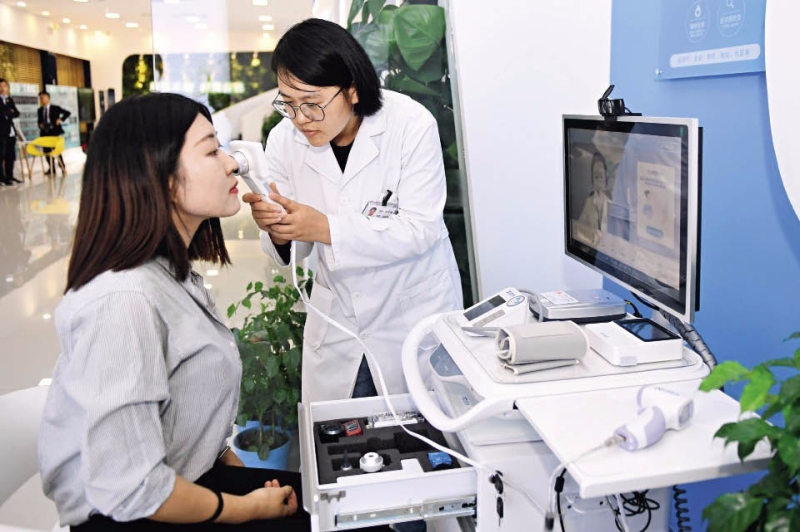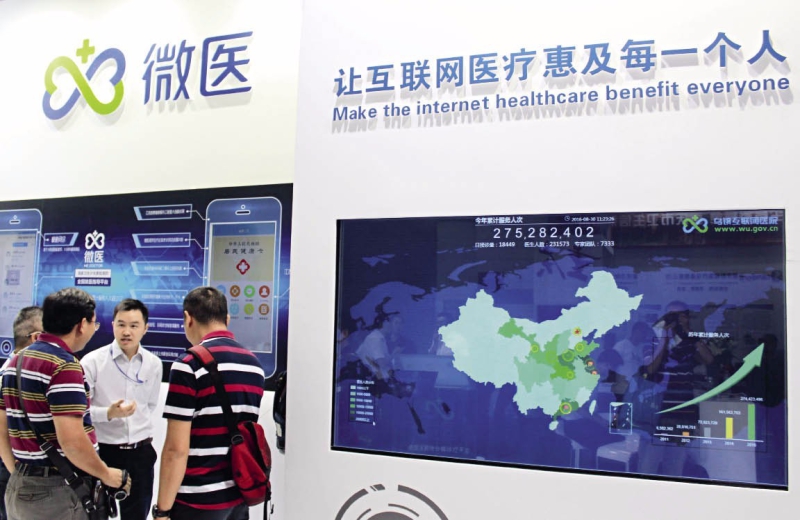NIU LUQING is a senior reporter at the New Economy Weekly, Development Research Center of the State Council.

NIU LUQING is a senior reporter at the New Economy Weekly, Development Research Center of the State Council.
Accelerating Equal Access to Health Care
One morning in May 2017, Zhang Qiangbin, a farmer in Duangou Village, Jiaxian County of Henan Province, suddenly felt some chest pain and dizziness. The village doctor Wang Tingjie used the remote electrocardio (ECG) system of his clinic to check the patient and uploaded the ECG data to the Jiaxian County Traditional Chinese Medicine Hospital. After expert consultation, the diagnosis of the patient was aortic dissection. Subsequently, Zhang was urgently transferred to the First Affiliated Hospital of Zhengzhou University, and his life was saved. “Little did I think that the Internet could save lives at a critical time,” said Zhang with emotion when recalling the situation.
Guo Hao, head of the Anliang Town Central Hospital, said that new technologies and apparatuses such as telemedicine, remote ECGs, and physical examination vehicles using cloud technologies are now benefiting 41 villages under the jurisdiction of Anliang Town and helping 50,000 local villagers enjoy convenient medical services. The system also allows grassroots doctors to easily consult with higher-level experts in different fields of medicine.
The Internet hospital has become a service platform that integrates online appointments, consultations, prescribing and delivering medicine, and online and offline diagnosis and treatment with the help of Internet technology. Integrating physical hospitals into the platform provides strong support for the Internet hospital in conducting consultations, follow-up visits, and chronic disease management on the Internet. When patients go to the hospital for the first time, they must go to a physical hospital to do examinations and create medical records. After that, for further consultation, doctors use the Internet hospital platform to make further diagnosis and suggestions based on pictures and videos. For simple problems, patients no longer need to go to a physical hospital, and patients with chronic or common diseases can renew prescriptions online. This not only saves patients’ money on commuting, but can also promptly provide them with medical advice the moment they come down with an illness.
Cloud physical examination vehicles are also a vivid manifestation of the online and offline connection provided by the Internet hospital. This vehicle looks like an ordinary van, but it is equipped with such advanced equipment as a biochemical analyzer, B-mode ultrasound machine, and electrocardiogram machine. It can perform physical examinations and data entry at any location any time, and then update the residents’ health records in real time. According to Guo Hao, these vehicles can travel to all the villages under the jurisdiction of Anliang Town, providing one-stop smart services such as ECG, B-mode ultrasound, biochemical, and urine tests for key populations such as the elderly, children, pregnant women, and people with chronic diseases. “One vehicle can serve hundreds of people within a few hours, and the service results are sent to their mobile phones and the provincial public health platform in real time.”
The Internet breaks through space limitations and combines with physical hospitals, so that people in remote areas can also enjoy high-quality medical resources. Take We Doctor, one of the largest Internet hospital platforms at present, as an example. At present, it has assisted more than 10 cities including Tianjin, Pingdingshan, and Sanming to build a digital health community, covering a population of more than 25 million people.
In addition to hospitals utilizing online medicine dispensing and delivery services, many physical pharmacies have joined hands with take-out platforms such as Eleme and Meituan. Patients can now buy over-the-counter medicine in these pharmacies, and the medicine they purchase will be delivered to them by take-out. Usually, medicine can be delivered to the home in about half an hour of the purchase, which eliminates the pain and inconvenience of the patient going out when they are sick.

On November 6, 2018, a visitor receives a physical examination at the “smart clinic” of Wuzhen Internet Hospital.
From Medical Centers to Health Centers
Liao Jieyuan, founder and CEO of We Doctor, believes digital health services have great prospects. In the era of consumer-oriented Internet, only Alibaba’s digital platform has a transaction value of more than RMB 1 trillion. And China’s pharmaceutical circulation market has an annual transaction size of more than RMB 2.2 trillion, and is continuing to grow rapidly. In other words, in the era of the industrial Internet, China’s second trillion-yuan digital trading platform may appear in the medical and health field.
Judging from the existing achievements, digital platforms have played an enormous role in promoting coordinated medical services, medical insurance, and pharmaceutical reforms, and will be able to effectively reduce the price of medicine. For example, the digital platform Haixi Pharmaceutical Trading Center in Sanming City, Fujian Province, has realized centralized procurement of pharmaceutical consumables across the country, saving RMB 7.36 billion over seven years. Last April, the center was entrusted by the National Healthcare Security Administration to build a nationwide drug and medical consumables bidding and procurement management subsystem, promote the establishment of a regional drug procurement platform, realize joint drug procurement, bargaining, trading, settlement and supervision, and further reduce purchasing prices, which as a result can save at least RMB 600 billion in fiscal expenditures in one year.
At the 2019 China Entrepreneur Summit, Liao outlined the three stages of the new round of medical reform: first, reduce extortionate drug prices through the joint procurement of pharmaceutical consumables; second, implement the tiered diagnosis and treatment model to solve the problem of imbalanced allocation of medical resources; and third, truly achieve the change from being medical treatment centered to health centered.
A Supervisory Platform Is Important
After undergoing rapid development, the Internet healthcare industry has also had to face many problems and find solutions to the following challenges: Since the Internet hospital is an emerging market in China, should it be fully commercialized or should more emphasis be put on its social value? Should it be established by the physical hospital or through cooperation with a third-party platform?
According to Wang Hang, founder and CEO of haodf.com, to insure steady development of medical care, quality is the core. During the development process of Internet hospitals, especially at present, combining business attempts with social welfare and basic social issues to take on social responsibility is the bottom line that the entire industry needs to adhere to. Regarding the future development of Internet healthcare, Wang believes that e-commerce can provide a valuable experience for the development of Internet hospitals. “Large companies such as Haier and Gree have their own e-commerce platforms, but the main sales still come from JD.com and Tmall.com. In this regard, Internet healthcare can learn from the development path of e-commerce,” he said.
Ensuring the professionalism and authority of online doctors and hospitals is another challenge Internet hospitals are facing. Internet + medical to Internet medical + supervision guarantee the safety and quality of online healthcare, which is another trend in the development of Internet hospitals. In January 2019, the Zhejiang Internet Hospital Platform was officially launched as China’s first “service + supervision” Internet hospital platform. Through this “service + supervision” integrated sharing platform, all institutions that provide Internet diagnosis and treatment services are supervised. This includes the supervision of online medical institutions and diagnosis subjects, the supervision of medical institutions that carry out online diagnosis and treatment and their medical business scope, the supervision of the qualification of doctors, nurses, and pharmacists, and comprehensive supervision of online prescriptions. In this way it ensures the standardized practice and professionalism of hospitals and online doctors, greatly improving the safety of online diagnosis and treatment. Subsequently, Anhui, Hainan, and other provinces successively established supervision platforms to draw a “red line” for the safety of online diagnosis and treatment.
Today, major top-class hospitals and specialized hospitals have gradually integrated into the Internet hospital platform, and other hospitals are also setting up their own online platforms. With the popularization of 5G technology, the potential of Internet hospitals cannot be underestimated.